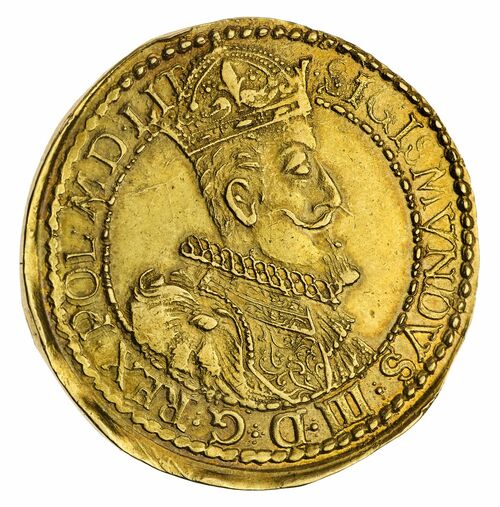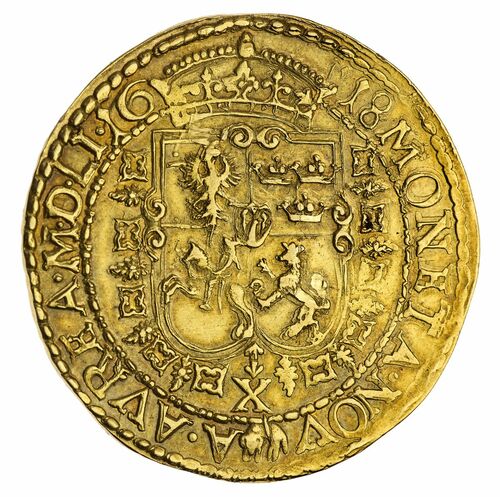Auction: 24005 - The Official Coinex Auction of Ancient, British and World Coins
Lot: 673
NGC AU55 | *Top Pop* | Polish-Lithuanian Commonwealth, Grand Duchy of Lithuania, Sigismund III 'Vasa', King of Poland (1587-1632), Commemorative "Siege of Moscow" and "Treaty of Dywilino" Presentation Gold 10-Florin Piece and "Chodkiewicz Campaign" War Portugalöser of 10-Ducats, 1618 [Bogoryian Arrow], signed by Jonušas Stypla (Mintmaster) and Hieronim Wollowicz (Treasurer) for Jan Karol Chodkiewicz (Supervisor) of the Vilnius Mint [Wilno], Upon the Deulino Truce concluding the Polish–Muscovite War, SIGISMVNDVS · III · D: G · REX · POL · MD · LIT, crowned, collared, draped and cuirassed bust right, wearing damascene armour, rev. MONETA · NOV-A · AVREA · M · D · 16-18, crowned square-topped Garter shield emblazoned with the Coat of Arms of the Vasa Dynasty (first quarter: Polish eagle, second quarter: Three Crowns of Sweden, third quarter: Lithuanian rider; fourth quarter: Folkung lion), surrounded by a chain of the Order of the Golden Fleece, X and small arrow below the Vytis [Stypla's Mark], 34.497g, 12h (Hutten-Czapski 7478 [R7]; Józef Tyszkiewicz, p. 34 not listed; Chelminski-Szarawka - [cf. 384 same obverse die]; Kopicki 3570 [R8]; Kurpiewski 2191 [R8]; Gumowski 1430; 'The Knight', Lithuanian Numismatic Association, Vol. V, No. 1, June-July 1982, p. 331, Fig. 113, no. 5 same dies; Ivanauskas 9SV7-6; Taraszka 24010 same dies; Fb. 4), historic scuffing above Polish Eagle and body of Folkung Lion, with usual radial die breaks behind crown to M, otherwise struck on a handsomely broad round planchet with a hint of doubling in legends, exhibiting soft but attractive and natural honey-golden tone further accentuated by residual lustrous flare, almost extremely fine for issue, AN OUTSTANDING EXAMPLE OF THE HIGHEST RARITY AND IMPORTANCE TO POLISH-LITHUANIA NUMISMATICS, the date unknown to Chelminski, in NGC holder, graded AU55 (Cert. #8220686-001) [*Single Finest Certified*]
Provenance
A Relict of a European Emigré from the Second World War
In 1545, the Land Treasurer of the Grand Duchy of Lithuania, Iwan Hornostaj bought a building for a Mint in Vilnius on Vokieciu street at the cost 500 kapas of Lithuanian groats. He purchased modern equipment from Western Europe and die engravers were also hired. Silver would mainly be supplied from Krakow, but some was sourced from Danzig as well. Initially, coins were minted to satisfy the needs of both market and ruler.
Traditional coins such as denarii, half-groats, groats and unprecedentedly obols, worth a half-denarius, were struck from the outset. To facilitate trade with both Poland and Prussia, coins were struck on the Polish weight standard. The first gold coins - ducats - were minted from 1547. The output at Vilnius in the earliest years of operation were sizeable: 881,204 obols and 375,263 groats were struck between 1545 and 1546, meanwhile 5,688,160 denarii and 3,627,571 half-groats were produced from 1550 to 1554. However due to the ongoing shortage of silver and the low seignorage fee, Sigismund Augustus outsourced the mint to Jewish businessmen. The mint thus came under the leadership of Gabrielius Tarla in 1555, but soon after followed huge dissatisfaction over his reduced purity for the coins produced, prompting his dismissal in 1565.
The Royal marriage between the houses of Vasa and Jagiellon at Vilnius in October 1562 prompted the first strikings of Commemorative Gold 10-Ducats (Portugaloser) at the mint, ready for distribution amongst the most distinguished guests present. In 1566, Sigismund Augustus granted the privilege of control over the Vilnius Mint to the Land Treasurer, Mikalojus Naruševi?ius. He was granted even greater autonomy in the 1568 Resolution of the Seimas in Grodno, which transferred maintenance of the mint, the hiring of towns and the payment of wages to him suo jure. After the Union of Lublin was signed on 1 July 1569, the Vilnius Mint soon thereafter discontinued its operations.
The Mint re-opened in 1577 having largely retained its own staff. The Leliva coat of arms of Jonas Glebavilius, then Land Treasurer, was stamped on the coins from 1580 to 1583, but this ceased in 1584. The coins of 1585 and 1586 contain the coat of arms of Chancellor Leonas Sapieha. Under the rule of Stephen Bathory, the Mint began issuing shillings for the first time, but minted mainly three-groat pieces. Contemporaneous strikings of thalers and ducats were severely limited, but the recovery of Polotsk, caused further 10-Ducat coins to be struck in 1580. Following the accession of Sigismund III in 1587, he committed to allow the Treasury to govern the Mint. The Mint Supervisor was the Voivode of Vilnius, Krzysztof Mikolaj Radziwill, nicknamed "the Thunderbolt". In 1597, the first distinctive mark of a Coin master was added to the three-groat pieces - a bull's head, pierced by two hooks - signifying the work of Simon Luderman, who later became a distinguished mint-master at Mecklenburg. The King visited Vilnius in 1601 and ordered the Mint to close on the account of the poor quality of his coinage, but again this was only a temporary measure for it re-opened again in 1606 under the comptrollership of Mikolaj Krzysztof Radziwill, dubbed "the Orphan".
Tragedy struck the mint again in 1615 when a devastating fire razed the entire premises. Overseeing the swift rebuilding project was the new mint supervisor Jan Karol Chodkiewicz, who also oversaw the introduction of more efficient coin rollers. He would engage in the striking of further Commemorative Gold 10-Ducats in celebration of the 50th Birthday of King Sigismund in 1616, and again in 1617 and 1618 to mark the success of his own personal military campaigns on behalf of Prince Wladislaw in his March to Moscow, during which time this totemic offering was struck. The inclusion of personal marks (arrow) is especially interesting, for Sigismund III had expressly outlawed the placing of such on Lithuanian specie as far back as 1600.
https://www.ngccoin.uk/certlookup/8220686-001/55/
Subject to 20% VAT on Buyer’s Premium. For more information please view Terms and Conditions for Buyers.
Sold for
£130,000
Starting price
£70000























